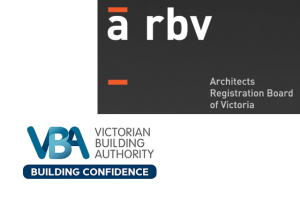Architect, Building Designer, Draftsperson… Don’t they all do the same thing!?
If you are looking to build or renovate, and without experience in dealing with a home designer, you may be confused about the cost/benefit of these different options. As a currently registered building designer and a currently registered architect, I hope to shed some light on the topic and provide some further information about the differences and suitability of each for your project.
Requirements for registration as an Architect are similar Australia-wide, but the requirements for a building designer vary broadly by state. This comparison focuses on Victoria, where building designers (also referred to as draftspersons) must be registered with their state body, similar to Tasmania and Queensland. The other states offer some form of voluntary accreditation which would be wise to consider when selecting your designer in those areas.
SUMMARY
| Architect | Building Designer | |
|---|---|---|
| Min. Education | 5 Years | 2 Years |
| Education Focus | Design Skills | Technical Skills |
| Min. Experience | 2 Years | 1 Years |
| Registration Testing Focus | Practical/Legal/Regulatory | Regulatory |
| PI Insurance | $1,000,000 Minimum – Vic | $500,000 Minimum – Vic |
| Registration Body | ARBV – Vic (or State Body) | VBA – Vic (or State Body or None) |
EDUCATION
An architect must have completed both an undergraduate degree and a postgraduate degree (Master of Architecture). Together this is 5 years of formal education. A building designer on the other hand must have completed the equivalent of a 2 year Diploma.
Each institution will have their own particular focus, but there is a difference in the learning style between the two options. The TAFE course units generally focus on technical skills, rules and regulations. The 5 year architecture degree provides for learning of rules and processes, but it is much more heavily skewed toward design and problem solving.
 EXPERIENCE
EXPERIENCE
Registration as an architect requires a minimum of 2 years experience. 3,300 hours of this experience must be logged as directly performing specific tasks, ensuring a registered architect has experience in all facets of the field. Each criteria must be logged at a minimum number of hours, and these range from design skills, client support, documentation, regulations and involvement in the construction process.
A building designer requires a year of full-time experience in the industry. This experience must be directly related to production of construction documentation as a minimum.
In both cases it is uncommon but possible that applicants applying for registration have only the bare minimum experience requirements. Within 2 years an architecture graduate often hasn’t actually logged experience in all of the criteria, so would not yet be eligible for registration. A building designer will also need some additional information and industry contacts in order to confirm their suitability within the 1 year timeframe. Experience continues well after registration, and this should also be considered in both cases when selecting a designer.
REGISTRATION PROCESS
Having completed both processes myself, there are many differences between the focus of each.
Once an architect has satisfied the above requirements as well as detailed a log book of experience showing that they have 3300 hours of experience in key areas, they can apply for registration. This involves a submission detailing their experience for assessment. The next stage involves an examination, followed by a one hour interview if passed. The focus of the exam is on problem solving real life situations which could occur in the field, whilst the hour long interview is designed as a consumer protection process. The interview ensures that those who made it through the exam genuinely possess the knowledge, skills and ethics to become an Architect.
Once a building designer has satisfied their minimum requirements, as well as provide industry references (for consumer protection) and an example of their drawings, they too must go through a process of testing. They must undertake an exam which asks questions directly relating to the National Construction Code, Australian Standards and the Building Regulations. There can be an interview process in some cases.
Registration as an Architect focuses on ethical, design, legal and regulatory issues, whilst registration as a building designer has a more in-depth focus on rules and regulations specifically.
 INSURANCE & LEGAL RESPONSIBILITY
INSURANCE & LEGAL RESPONSIBILITY
One major difference in favour of selecting an Architect is that they do hold greater legal responsibility and liability with their work. Using an architect means that you are assured of the minimum standard of skill and professionalism of a “reasonably competent architect”. This provides some greater recourse if a mistake were made. Where real professional negligence has occurred, both architect and building designer would be held accountable similarly.
The minimum insurance requirements for an architect are higher, though both architects and building designers are likely to have greater than the minimum insurance level if they complete larger projects. Where your project budget is beyond the minimum requirements in the summary at the top of this page, you may wish to ask whether they have higher levels of PI Insurance when selecting your architect or building designer.
DESIGN
The knowledge and use of design principles is a potential difference between the two. In theory, an Architect would excel in this area over a building designer due to the learning, experience and registration requirements having a much greater focus on this area. For this reason you are assured that all architects have some form of learning, experience and assessment in design. The building design registration requirements do not directly assess any design skills, though there would generally be some design skills taught at TAFE.
Like all professionals, some designers are better than others and design skill will vary based on the practice, experience and personnel rather than just whether one person is an architect or not. There are many building designers who possess similar skills and you can assess this based on their folio of work, even if they haven’t formally been required to undertake learning or assessment in the area as a professional.
Design is a problem-solving skill which determines much of your final product. The skill involves finding creative ways to adhere to the building regulations, using the site/climate to its full potential, incorporating your lifestyle needs and much more. It is more than simply what your final project looks and feels like. Where your project is of a reasonable scale, this is a key requirement to consider to increase the value that your construction budget will provide.
 SERVICES
SERVICES
Services provided by each can be very similar as both will take your project through the same permit processes. The biggest difference in services offered is that Architects historically offer ‘contract administration’, whereas building designers do not.
Contract administration essentially provides a third party to your building contract in order to assure the quality of the build and a smooth process. An architect will confirm that the building is constructed according to the documentation, that payments accurately represent work completed and provide advice during the construction stage. This can help to ensure no shortcuts are taken with workmanship or materials, and avoid disputes during the construction process.
CONCLUSION
There is always crossover between the very closely related fields and you should select the individual or business based on their strengths. In general, where the job is simple and minimal design skills are required, a building designer can be a good choice. Building Designers are generally thought to be cheaper and often can be, however this is certainly not correct in all cases. You should still consider ‘design skill’ as a factor in your selection, as good knowledge or advice where you may not think this is required can improve the quality and value of the space dramatically. Where design expertise is definitely required, or where you would like to engage a third party to administer your building contract, an Architect would often be a better choice. There are many cases where a building designer may have the design flair and knowledge required for this type of project though, so you should assess each designer on their merits.
Additional Info: Architect is a protected term, no one can legally use it unless they possess the above knowledge and are registered. Building Designer is not a protected term, however in Victoria anyone who calls themselves a Building Designer but is not registered will risk having their plans rejected, and no building permit issued. For this reason it is uncommon that anyone would use the term without being registered, but you should always ensure that your building designer or draftsperson is a ‘Registered Building Practitioner’ if you elect to go down that path.